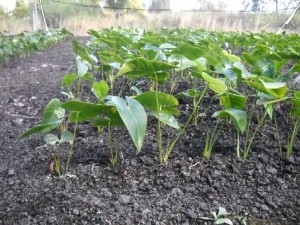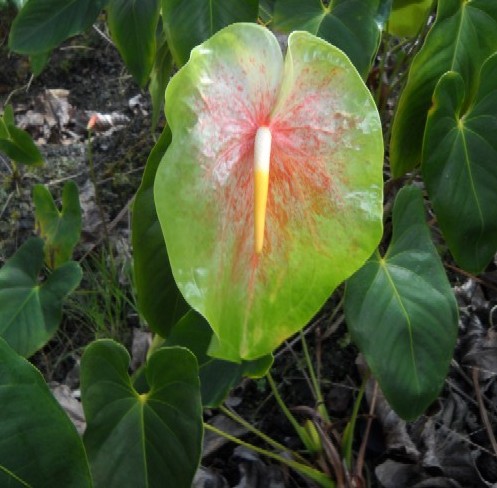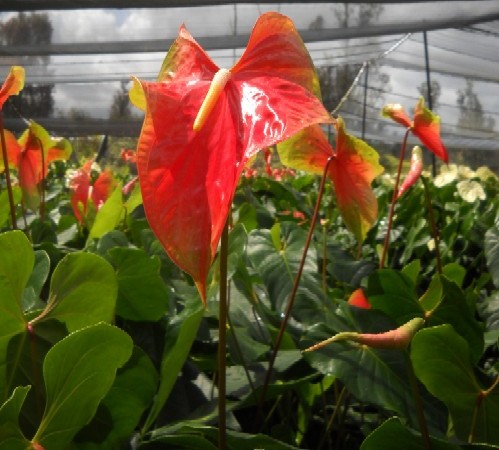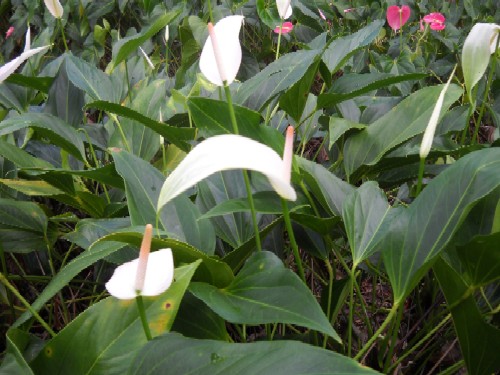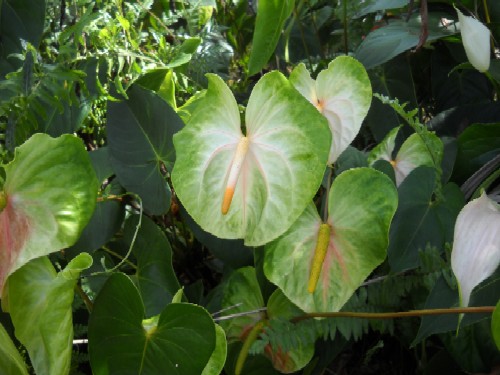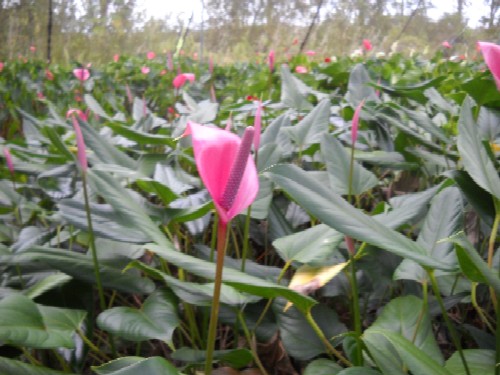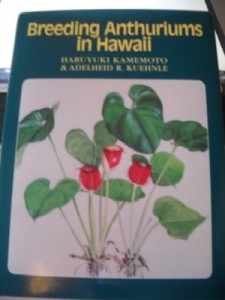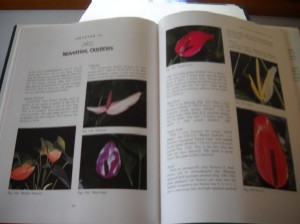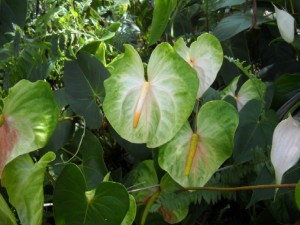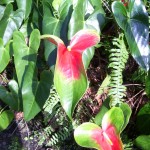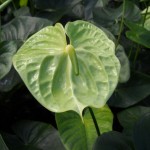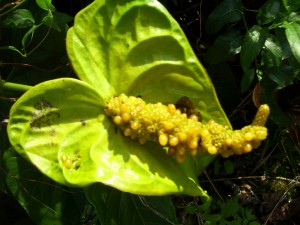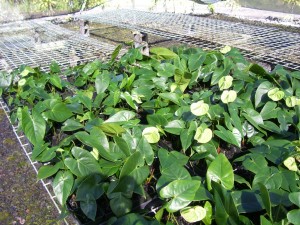Anthurium Plant Problems
Many anthurium plant problems are easily avoidable and can be avoided by following a few simple anthurium care guidelines. Today I am going to talk about the problems that can be caused by giving them too much or too little water, exposing them to incorrect temperature ranges, and providing them too much or too little light.
Watering
Anthurium plants like water but they also like it when their roots can breathe. Water them regularly or they will be stunted or even die. But water them too much and they will experience root rot, have their leaves turn yellow and eventually die.
There are two secrets to watering them.
The first secret involves a lot more work than the second, so it is more prone to resulting in over or under watering. It is to always check the potting media before watering. If it’s soaked, then wait a while before watering. You want to water your plant before the media becomes bone dry and after it is no longer soggy. There should still be a hint of moisture or the roots of your plant will go into shock, and the roots will struggle to absorb water again.
The second secret is to do what we do on the farm, which is to grow them in volcanic cinder. Cinder is a highly porous media that drains exceptionally well. So if you forget to water your plant it probably isn’t the media for you. But it drains so well that your plant can be watered daily without root rot as long as you remember to empty the drip tray that your pot is sitting in. You don’t even have to check if it is soggy; you just wake up in the morning and water your plant. By the following morning the cinder will have dried sufficiently for you to water your plant again, without fear of root rot.
Temperature
Anthuriums like most people don’t like extreme temperatures. Freezing weather will kill them. Hot weather, above 90 degrees, can burn their leaves and damage their flowers. Cold weather below 50 degrees can reduce their rate of growth and cause their leaves to turn yellow. They prefer to be kept at temperatures between 70 to 90 degrees.
Light
Excessive direct sunlight will burn the leaves and flowers of your plant. When left in strong sun, the leaves of your plant will start to turn yellow. If you don’t heed this warning sign, next the leaves will turn brown and die. Anthuriums can tolerate a fair amount of shade, since in their native habitat, they live under the highly shaded canopy of a rain forest, but too little light can cause stunted growth and a decrease in flower production. So if this starts to happen to your plant, give it a little more light.
Private Reserve
Here are pictures of the rarer and more exotic varieties of anthurium plants that we grow on our farm. They are not for sale at the moment, but from time to time we may offer them for sale. When we do sell them, they will only be available in extremely limited quantities.
If you would like to receive notice when we sell these scarce varieties, please make sure that you are on our mailing list.
Breeding Anthuriums in Hawaii
If you are looking for a step by step guide to breeding anthuriums, this book isn’t for you. It does give a brief summary of the steps involved in pollinating anthuriums and germinating the resulting seeds, but I feel that it assumes that the reader already understands how to do this and also knows how to raise and care for anthuriums. It also discusses micro-propagation, e.g. tissue culture, and genetic engineering, but this is probably beyond the scope of most enthusiasts.
But if you are looking for background on: Hawaii’s anthurium industry, the major anthurium species, the origins of many of today’s best cultivars, and the inheritance of color traits, this is the book for you. And if you like pictures of anthuriums, this book has a lot of full color pictures of many different varieties of anthuriums.
Click Here To Buy This Book On Amazon.
This book starts out by providing an overview on the major groupings of anthurium species. Then it covers the relationships between species. It gives a partial indication of which species can be interbred and which species the authors were unable to cross. It has a large table with the chromosome counts of various species, which can be helpful when selecting species to crossbreed.
It also describes some of the interspecific hybrids that the authors were able to successfully create and it also provides pictures and descriptions of these hybrids. This is a good starting point if you are thinking of producing your own hybrids.
There’s a chapter on the inheritance of color. If you cross a red and a white, you would think that you’d get pink, but this is not always the case. Sometimes you get orange. Who would expect that? This chapter goes on to cover many of the crosses between the five major color groups.
This book also covers breeding of standards, obake and potted as opposed to cut flower cultivars. It even has a section on novelties and oddities. Did you know that there’s a very unusual novelty named “satan”? It is one of the most unusual looking anthuriums that I’ve ever seen.
This book was written by Professor Haruyuki Kamemoto and Adelheid Kuehnle. Professor Kamemoto is emeritus professor of horticulture at the University of Hawaii and he is one of the founding fathers of the anthurium industry in Hawaii. He started the U.H.’s anthurium program in 1950 and has been developing new varieties of anthuriums for more than fifty years. He has also done amazing things for Hawaii’s orchid industry, too. Talk about a talented guy.
Click Here To Buy This Book On Amazon.
If you buy it directly from Amazon, this book costs over $30. But if you are lucky like I was, you may be able to find a new copy selling for less than $10 from one of the other vendors in the Amazon store.
How To Pack Anthurium Plants For Shipping
In this video, Samantha demonstrates how we pack our anthurium plants for shipping. This method tends to work well for shipping plants, though we do run into the occasional broken flower. Flowers are much harder to ship when they are still attached to plants as opposed to when they are packed as cut flowers.
Video Summary
- Wrap the roots of the anthurium with damp paper towels, so that they don’t dry out.
- Wrap clear plastic wrap around the paper towels, so that they retain the moisture and prevent the water from leaking into the box.
- Carefully wrap the anthurium plant and its leaves with newspaper to protect them.
- Use tape to secure the newspaper.
- Don’t forget to label the plant with a permanent marker.
- Use packing peanuts or shredded newspaper as padding when placing the anthuriums into their box for shipping.
Mauna Loa Anthurium
Mauna Loa Anthurium Flowers are obake anthuriums that are white and green. They tend to be white in the center and green at the edges. Mature plants can produce extra large flowers.
Ancestry of the Mauna Loa
The Mauna Loa’s mother plant was a Tropic Ice, but we don’t know who the father anthurium plant was as the Tropic Ice was open pollinated. What this means is that the pollination didn’t occur under controlled conditions, so no one knows exactly which plant produced the pollen that fertilized the Tropic Ice and fathered in the Mauna Loa.
It is a great variety for growers because it is blight tolerant and anthracnose resistant and it is also a favorite of people who like cut flowers as it can last up to 56 days in a vase when freshly cut. And even after being dry packed for three days it can still last 39 days in a vase.
How the Mauna Loa Anthurium Got Its Name
The Mauna Loa Anthurium was named after Mauna Loa, which is the second tallest of the five volcanoes that make up the Big Island. It is also the largest volcano in the world when measured by volume. Translated from Hawaiian to English, its name means “Long Mountain.” It is an active volcano that last erupted in 1984. The city of Hilo, which is the most populated city on the Big Island, is built upon its slopes, so any eruption of Mauna Loa poses great danger to the city.
Marian Seefurth Anthurium
The Marian Seefurth is one of the earliest varieties of anthurium developed by the University of Hawaii. It produces a beautiful pink flower and it was released all the way back in 1963. It produces close to seven flowers a year, but it is susceptible to blight. Fortunately, it displays some resistance to anthracnose.
On our farm, our Marian Seefurth’s tend to be a little more susceptible to fungal issues with their foliage than some of the other varieties that we grow. The standard solution to this problem is frequent applications of fungicide. But rather than load up on the fungicide we try to keep things under control by spacing these plants a little further apart for better air circulation, removing heavily infested plants and carefully adjusting moisture levels.
How did the Marian Seefurth Anthurium get its name?
It was named after Marian Seefurth, who was the wife of Nathaniel Seefurth who made a generous donation to the University of Hawaii to further anthurium research.
Anthurium Scherzerianum: An Excellent Anthurium Plant With A Funny Name
Anthurium Scherzerianum that just rolls off the tongue, doesn’t it? I know, it’s a very long and funny name for such a remarkable plant. It is also known as the Flamingo Flower. It produces lovely flowers that can be red, orange or reddish-orange. Its most distinctive feature is that it produces a spadix that is curlier than a pig’s tail. So why is it called the flamingo flower instead of the pig flower? Who knows?
Basic Facts
Family: Araceae
Genus: Anthurium
Species: Scherzerianum
Latin name: Anthurium scherzerianum
Common name: Flamingo Flower
Climate: Tropical
Minimal temperature: 59-64°F, reduce watering at these temps
Best temperature: 78-86°F
Recommended place: bright morning or evening light, with partial shade
Soil: peat-humus, porous, loose
Flower color: red, orange or reddish-orange
Repotting Frequency: every 2 years
Country Of Origin: Costa Rica
Background Information
This species is originally from Costa Rica where it grows in rain forests. It is grown all over the world and there are now more than forty cultivars. The easiest way to distinguish this species from the Andraeanum species is to look at the spadix. The spadix of Andraeanum is straight, while the spadix of the Scherzerianum is very curly.
Growing Conditions
The Flamingo Flower likes tropical conditions, but it can also tolerate winter as long as it is kept above 65 degrees, though the ideal temperature for it is 75 to 85 degrees. It prefers high humidity and a great deal of moisture, but you must be careful of standing water, which can cause root rot. If you live in a dry climate, misting it twice a day can provide the humidity that it requires. It also requires partial shade, full sunlight can burn it. But if the light is insufficient it will grow slower and produce few flowers. During the cooler times of the year, you should reduce the amount of water that you give it.
Propagation
There are three ways to propagate this species. The first and easiest method is via cuttings. These plants can be cut in half, provided that each half retains three or more growing nodes and each half will continue to grow if potted separately. The second and slightly more difficult method is via seeds. Creating seeds will usually require manual pollination. If you only have one plant, self pollination is possible if you are willing to store pollen in the freezer, though it takes much longer to propagate via seed. Seeds do not keep for very long, so you have to plant them as soon as they ripen. Finally, if you have a lab, you can also propagate these plants with tissue culture, but this is definitely beyond the reach of most enthusiasts.
A Common Mistake
The “flower” is not really the flower of these plants. It is a modified leaf or spathe. It is essentially a leaf that is a different color. The true flower of the plant is found on the spadix or nose of the “flower”. The spadix holds microscopic inflorescences which consist of the both the stigma and the stamen of these plants. These flowers are perfect in that each flower has male and female parts; however, these parts are active at different times, so self pollination rarely occurs without human help and the storage of pollen in the freezer until the stigma is ready to be fertilized.
Anthurium Andraeanum a.k.a. Andreanum
Anthurium Andraeanum is an extremely popular species of flowering plant from the Araceae family. There are between 800 and 1000 known species of anthurium, but Andraeanum which is also commonly spelled Andreanum is by far the most popular and most commonly grown species. Various Andraeanum cultivars form the core of the anthurium flower industry, which started back in the late 1940s in Hawaii.
Anthurium Facts
Family: Araceae
Genus: Anthurium
Species: Andraeanum
Plant Type: Herbaceous perennial
Zone: 11 to 12
Height: 1 to 1.5 feet
Spread: 0.75 to 1 foot
Bloom Time: Flowers freely
Sun: Part shade
Water: Medium
Maintenance: Medium
Uses: House plant, cut flower
Common Names
Anthurium, tail flower, flamingo flower, cresto de gallo, cockscomb, anturio and boy flower. But anthurium is the common name that is used most widely.
Common Misspellings
Antherium, anturium, arunthium, anthorium, anthiriums, antariam, antorlium, anthuriam, anthrurium, anthirium, anterium and antorium.
Noteworthy Attributes
These plants are native to Central and South America, however many of the original cultivars were initially developed in Hawaii. They produce 6 to 12 heart-shaped flowers a year in a wide assortment of colors. Plants grow to an average of three feet tall, though they can grow much taller in the proper environment. They produce heart shaped leaves that can range from 8 to 18 inches long. It flowers year round in tropical conditions and seeds are unlikely to be produced on indoor plants without manual pollination procedures.
Anthurium Care Guidelines
Outside of the tropics, it can be grown in most parts of the world as a potted houseplant. Proper anthurium care starts with using a very well-drained potting mixture. And remember to put a layer of pot shards, marbles or gravel at the bottom of the pot to further ensure good drainage. Bright light is required, but direct sunlight can burn these plants. They require consistent watering throughout the year and they do not go dormant during the winter. Ensure that they are not exposed to temperatures less than 60 degrees for any extended period. They require high humidity or frequent misting with water. Repot every two years and utilize a thin layer of sphagnum or peat moss on the surface to retain a little moisture.
Caution Poisonous
Anthuriums can be poisonous to humans and pets. They contain Calcium oxalate which can cause oral irritation and difficulty swallowing, so keep them out of reach of children and pets.
Solutions To Common Anthurium Problems
Dark Spots On Leaves
If you keep your plant in a cold location and the leaves of your plant develop dark spots, you should try moving it to a warmer area.
Leaves Are Turning Yellow And Withering
This can be caused by excessive exposure to sunlight. If your plant is in a very sunny spot, try moving it to a location that receives less sunlight.
Scale Insect Infestation
If your plant is attacked by scale insects, mix a mild solution of soap and water and use a soft cloth to wipe down the leaves of your plant.
Stunted Growth And Small Shriveled Leaves
This may be caused by a fungal infection that is affecting the roots of your Anthurium Andraeanum. Prevent this from occurring by using a well drained potting soil and being careful with your watering. If this has already occurred, try repotting into a well drained soil and trimming away diseased portions of the plant.
Green Anthurium aka Midori Anthurium Plants
So far no one has been able to breed a blue anthurium, though I am sure that if scientists put their minds to it they could do so, much like they have done to create blue roses in the lab. As of now, the closest we can come to blue is the color green, at least green is next to blue in rainbows. Green anthurium plants are also known as Midori anthuriums.
We sell large green anthurium flowers for $3.50 per stem and plants for $29 per top cutting.
Click Here To See Our Catalog.
Green Anthurium Origins
This variety was created by a grower named Calvin Hayashi in 1985, right here, on the Big Island of Hawaii. I believe that the Midori is one of the most innovative varieties as it was the first and still the only variety of anthurium that is truly green. There are other varieties that may have some green in them or possess an off shade of green, but only the Midori is just solid green.
Vase Life
Another trait that makes this variety special is its vase life. It has one of the longer vase lives of all of the anthurium flowers. It can last a month or even more in a vase, if handled properly after being harvested. Proper handling consists of trimming half an inch off the bottom of their stems as soon as you receive them, placing them in clean water and making sure you put them in a room where the temperature stays close to 70 degrees.
An Interesting Phenomena
One interesting thing you’ll notice if you buy a green anthurium plant is something that growers actually try to avoid. When these flowers are left on the plant for too long, they start to change color. Growers obviously do not want to see this happen, but if you are like me, you’ll find that this actually makes them look even more interesting. If you leave the flowers on your plant, rather that putting them in a vase, you’ll find that they will develop copper colored highlights that contrast nicely with their regular smooth green surface.
Midori Anthurium Care
To keep your Midori alive, the number one rule is: don’t forget to water it. If you remember only one thing from this article, I hope that you remember that. These plants need to be watered regularly; they come from rain forests, after all. Next, after watering, make sure that all excess water is drained away and removed from the pot. If water is left in the pot it can cause the root system of your plant to rot away. Always, keep your plant in a room with a stable temperature, around 70 degrees. You can put it near a window, but block direct sunlight with a thin, gauzy curtain, so that your plant can receive filtered sunlight to avoid burning. Finally, give it a small amount of slow release fertilizer before the growing season in your area.
Anthurium Propagation: Seeds, Cuttings & Tissue Culture
There are three ways to propagate anthurium plants: you can take cuttings; you can grow them from seeds; or you can tissue culture them. Cuttings are easy for anyone to do. Seeds are a little more difficult to do, and tissue culture is generally reserved for scientists in labs or really advanced anthurium cultivators.
Anthurium Cuttings
Cuttings are by far the easiest way to propagate your anthurium plant. The best part about taking cuttings is that the plants you produce will look exactly the same as the parent plant. First, you must wait until your plant is big enough to allow a cutting to be taken. Generally you’ll want to see at least four nodes, or sets of leaves and roots, before taking a cutting. Once your plant is big enough, cut it in half, so that each portion has at least two nodes. Leave the base of your plant in its original pot and it will generate new growth. Then put the top cutting into a new pot, water it regularly and it will keep growing, too.
Anthurium Seeds
Anthurium seeds are another way to propagate your plant. However it is a much more difficult process and takes a lot more patience. The stigma and stamen of these flowers are active at different times, so if you want to produce seeds you will have to store pollen in the freezer or have two flowers at different stages of development. So the first thing you have to do is gather pollen. Use a paint brush to scrape pollen off the stamen and into a vial. Keep this vial in the freezer until you see that the stigmas are ready to be pollinated. Once you have a flower with receptive stigmas dust a little pollen over it. Next you will have to wait for approximately a year for seeds to be produced.
Anthurium Tissue Culture
Tissue culture is almost exclusive done within the confines of a lab, with the exception of really high end hobbyists and growers. It is best left to commercial growers because it is very expensive and is generally used when one wants to produce thousands of genetically identical plants. So how does an anthurium farmer tissue culture an anthurium plant?
First, the anthurium farmer chooses an ideal specimen. This specimen will be replicated thousands of times, so a lot of time and effort is put into choosing the very best specimen available. Once this precious plant is selected, the farmer takes it to a lab.
In the lab, a scientist confirms that the specimen is healthy and then chops off a piece of it. Then the scientist will sterilize the sample and put it into a beaker that contains an agar based gel. This beaker also contains special plant hormones that trigger the sample to form a callus, which is an undifferentiated mass of plant cells.
The callus is divided into many portions and then allowed to grow once more. This method is replicated multiple times. Once sufficient material is created, the calluses are moved to a growing media which contains plant hormones that cause the undifferentiated cells to transform into roots and shoots. This causes hundreds of plantlets to sprout from every callus.
After the plantlets have grown sufficiently, they’re transplanted into brand new flasks to mature further. Once they have reached a size where they can survive in open air, they are removed from the beakers and transferred into pots. These new plants are allowed to mature in the tightly controlled conditions of a plant nursery for a while. Then, after they have adjusted to growing in open air, they’re returned to the farmer for transplanting into his fields.

